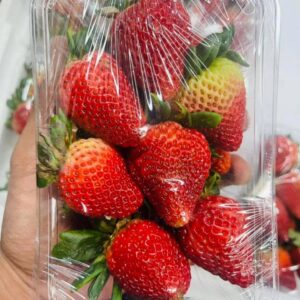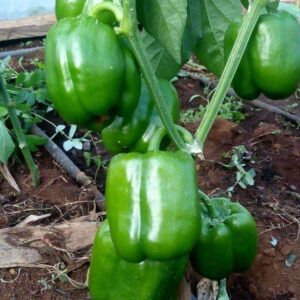The two most problematic diseases that afflict cucumber include bacterial wilt and powdery mildew. Bacterial wilt is controlled by eliminating its primary vector—the cucumber beetle. Incidence of powdery mildew can be lessened by providing adequate space between plants, eliminating weeds to increase air circulation, keeping the leaves dry by using drip instead of overhead irrigation, or using fungicides judiciously. Garden clean up in the fall also is helpful in reducing disease inoculums for the following growing season.
Most cucumbers varieties reach maturity in 50 to 65 days. The fruit will be firm to the touch and the skin will have a uniform dark green color. Cucumbers enlarge (mature) rapidly and should be checked/harvested daily. If left on the vine too long, the fruit becomes over-mature and less desirable. Slicing types are mature when about six to eight inches long; larger slicing varieties should be picked before they are ten inches long. Pickling varieties should be harvested after reaching a length of one to four inches. In either case, refrigerate harvested fruit as soon as possible to preserve flavor and avoid desiccation.
Cucumber Trivia:
- The largest cucumber ever grown was 67 inches long and weighed 154 pounds.
- Cucumbers contain 96 percent water.
- The inside of a cucumber can be up to 20 degrees cooler than its outside.
- One-half cup of sliced cucumbers contains only eight calories.
- Fresh extracts from cucumbers have recently been shown to have both antioxidant and anti-inflammatory properties.
- Placing a slice of cucumber on the eyelid can reduce puffiness. However, the beneficial affect is due to cool temperature and not to the cucumber per se.
- Try rubbing a cucumber slice over themirror in your bathroom; it will eliminate the fog andprovide a soothing, spa-likefragrance.
HYDRATION
Cucumbers are 95% water, according to WebMD . This makes cucumbers a great way to stay hydrated, especially during the summer.
“They say we can get 20-30 percent of our fluid needs through our diet alone, and foods like these certainly help,” added Lemond. “Not only are they high in water content, they also contain important nutrients that play a part in hydration like magnesium and potassium.”
The anti-inflammatory compounds in cucumbers help remove waste from the body and reduce skin irritation, according to the Cleveland Clinic. Preliminary research also suggests cucumbers promote anti-wrinkling and anti-aging activity, according to an article in the journal Filoterapia.
CANCER PREVENTION
Cucumbers contain two phytonutrient compounds associated with anti-cancer benefits: lignans and cucurbitacins. In recent years, pharmaceutical companies have been paying special attention to cucurbitacins, hoping to use them in new cancer drugs. According to a 2010 research review published in Scientific World Journal, scientists have found that cucurbitacins can help block the signaling pathways that are important for cancer cell proliferation and survival.
Cucurbitacins can also inhibits the growth of pancreatic cancer cells, according to a 2009 study published in the Journal of Cancer Research looked at cucurbitacin B (which cucumber contains) on human pancreatic cancer cells and found that cucurbitacin supplements inhibited the growth of seven pancreatic cancer cell lines by 50%, and also increased apoptosis, or “death by suicide,” of pancreatic cancer cells.
However, in 2021 Health Feedback assessed a claim made by Ethan Evans in his medical thriller, “The Eden Prescription” (BookSurge Publishing, 2010) that: “Cucumber kills lung cancer cells” and “cucurbitacin B suppressed growth of human lung cancer cells by 90%, reduced their ability to invade surrounding tissues by 75% and reduced migration ability by 88%.” Health Feedback stated that: “Some scientific studies found that cucurbitacin B, a biochemical compound in cucumbers, promotes regulated cell death” and “these studies were conducted on laboratory cell cultures and mice” meaning “there isn’t evidence showing that cucumber or cucurbitacin B kills tumor cells in people.” In short, whilst previous studies are certainly hopeful — the current evidence does not suggest that Cucumber kills or reduces lung cancer cells.
SKIN





Reviews
There are no reviews yet.